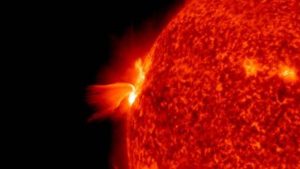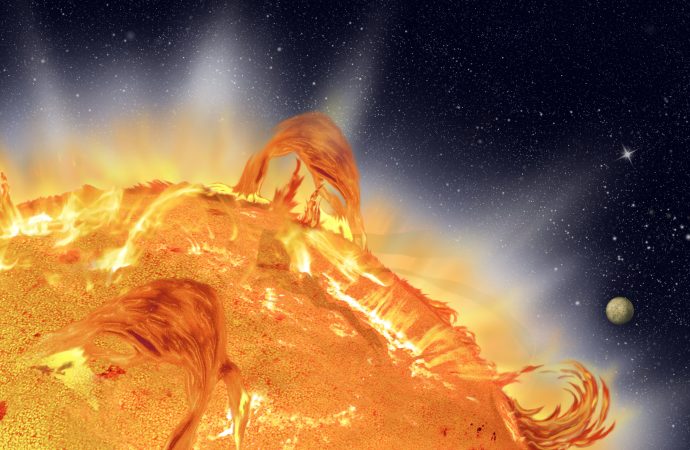Solar Fireworks: A Massive Eruption and the Spectacle of Auroras Approaching Earth The universe is a vast and mysterious realm, filled with celestial wonders that continue to amaze and astound us. In the coming days, Earth is set to witness a remarkable celestial event that promises to captivate our collective imagination—a massive solar eruption that
Solar Fireworks: A Massive Eruption and the Spectacle of Auroras Approaching Earth
The universe is a vast and mysterious realm, filled with celestial wonders that continue to amaze and astound us. In the coming days, Earth is set to witness a remarkable celestial event that promises to captivate our collective imagination—a massive solar eruption that will illuminate the night sky with breathtaking auroras. In this article, we’ll provide you with the latest updates on this cosmic spectacle, delve into the science behind it, and offer tips on how to witness this awe-inspiring event safely.
Solar Eruption: A Celestial Explosion
To understand the upcoming aurora spectacle, we must first delve into the source of this cosmic drama—a solar eruption. Solar eruptions, also known as solar flares or coronal mass ejections (CMEs), are dramatic explosions on the sun’s surface. They occur when magnetic energy stored in the sun’s atmosphere is released suddenly, causing a burst of energy and charged particles to be ejected into space.
The scale of these eruptions can be mind-boggling. Imagine an explosion so massive that it releases energy equivalent to millions of atomic bombs. This tremendous release of energy and particles hurtling through space is what sets the stage for the mesmerizing auroras that we are about to witness on Earth.
Auroras: The Dance of Lights
Auroras, commonly known as the Northern Lights (Aurora Borealis) in the Northern Hemisphere and the Southern Lights (Aurora Australis) in the Southern Hemisphere, are one of nature’s most dazzling light displays. These celestial phenomena occur when charged particles from the sun, primarily electrons and protons, interact with the Earth’s magnetic field.
The collision of these charged particles with the gases in our planet’s atmosphere, such as oxygen and nitrogen, results in the stunning dance of lights that we call auroras. Different gases produce different colors, giving rise to the vibrant hues of red, green, blue, and purple that adorn the night sky during an aurora.
Earth’s Tryst with Solar Explosions
Our planet has had a long and intricate relationship with solar eruptions. While the sun’s energy is essential for life on Earth, these eruptions can have a significant impact on our planet’s magnetic field and space weather. Solar flares and CMEs can disrupt satellite communications, GPS systems, and even power grids. Understanding these solar phenomena is crucial for safeguarding our technological infrastructure.
Over the years, scientists have made tremendous strides in predicting and monitoring solar eruptions, allowing us to prepare and mitigate their potential impacts on Earth. This scientific progress has also enabled us to anticipate and appreciate the beauty of auroras that these eruptions create.

Image by: https://www.space.com/why-solar-weather-forecast-doesnt-work
Anticipating the Aurora Spectacle
As Earth braces itself for the approaching solar eruption, anticipation runs high among astronomers, photographers, and sky gazers. While the exact timing and intensity of the auroras can be challenging to predict with absolute precision, several factors contribute to our anticipation:
- Solar Activity: The intensity of the auroras is closely tied to solar activity, specifically the strength of the solar eruption. A more powerful eruption is likely to result in more vibrant and widespread auroras.
- Geomagnetic Storms: The interaction between the solar particles and the Earth’s magnetic field can trigger geomagnetic storms. These storms enhance the visibility and extent of auroras, making them visible even at lower latitudes.
- Geographical Location: The viewing experience can vary depending on your geographical location. The Northern and Southern Hemispheres near the polar regions offer the best vantage points for witnessing these cosmic light shows.
- Clear Skies: Of course, clear skies are essential for observing any celestial event. Sky gazers often head to remote, light pollution-free areas for an unobstructed view of the auroras.
Safety Precautions for Sky Gazers
As we eagerly await this celestial spectacle, it’s important to prioritize safety when observing auroras. Here are some safety precautions to keep in mind:
- Protect Your Eyes: Never look directly at the sun, even during a solar eruption or aurora display. Use solar viewing glasses or telescopes with appropriate solar filters to protect your eyes.
- Dress Warmly: If you plan to watch the auroras in a cold climate, dress warmly in layers. It can get frigid during nighttime skywatching sessions.
- Stay Informed: Keep an eye on aurora forecasts and space weather updates to maximize your chances of witnessing the event.
- Share the Experience: Watching the auroras with friends or fellow enthusiasts can enhance the experience and provide an added layer of safety.
Upcoming Events and Viewing Opportunities
To make the most of this upcoming celestial spectacle, stay tuned for announcements of specific viewing opportunities in your region. Events like this often draw the attention of local astronomy clubs and enthusiasts who organize gatherings for collective skywatching.
Additionally, consider checking out virtual viewing events and live streams hosted by observatories and space agencies, allowing you to enjoy the auroras from the comfort of your home.
Expert Insights and Commentary
To shed further light on the significance and beauty of this impending celestial event, we’ve sought expert insights and commentary from renowned astronomers and space scientists. Their perspectives will offer a deeper understanding of the science and wonder behind this cosmic display.
The Cosmos Unveiled: A Grand Show Awaits
As the days pass and we draw nearer to the moment when the solar eruption reaches Earth, the anticipation continues to build. Nature is about to put on a grand show, painting the night sky with hues of celestial beauty. The universe, in all its splendor, is ready to unveil the cosmic fireworks—solar fireworks, that is.
So, whether you’re an avid sky gazer, an astronomy enthusiast, or simply someone who appreciates the marvels of the cosmos, keep your eyes on the night sky. Prepare to witness one of nature’s most breathtaking spectacles—the dance of lights known as the auroras, ignited by a massive solar eruption.
In the coming days, as the solar eruption approaches Earth and the auroras begin their celestial dance, remember that the universe is always ready to awe and inspire us. Stay tuned for updates, prepare your viewing equipment, and embrace the magic of the cosmos as it unfolds before your eyes.

















Leave a Comment
Your email address will not be published. Required fields are marked with *